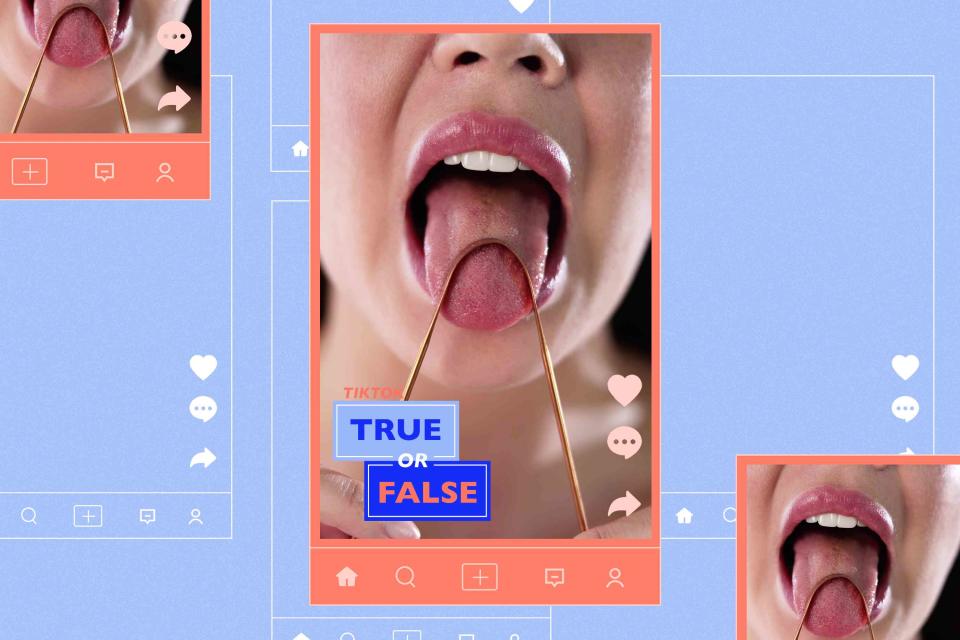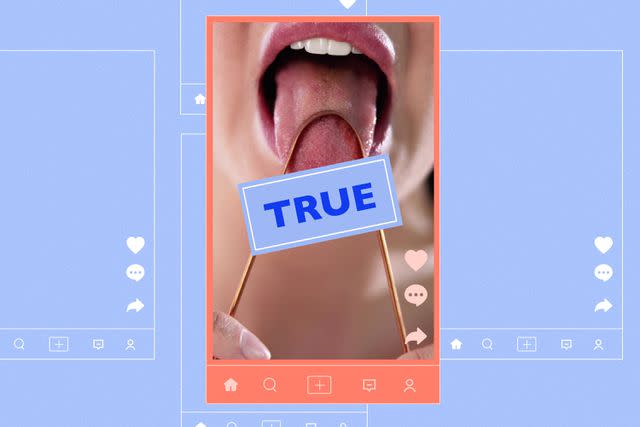TikTokers Say Tongue Scraping Can Cure Bad Breath, But Can It Really?
A dentist breaks down the effectiveness of this oral health routine.

Getty Images
TikTok True or False is the answer to your burning questions about the health, beauty, and fitness fads taking over your social feeds. Each story breaks down a buzzy wellness trend with the help of experts and scientific research to uncover the truth and safety behind the viral "advice" you see online. You'll never have to wonder what's actually legit—or what to skip—again.
TikTok is full of wellness and beauty tips that are potentially life-changing—and some that don’t actually work or may even be dangerous. While some of these tips come from the brilliant minds of the content creators themselves, the tongue scraping TikTok trend is anything but a fad. It has actually been practiced for centuries (and even millennia) around the world. Notably, it is an essential practice within the ancient health system of Ayurveda, which has existed for several thousand years.
Tongue scraping—according to TikTok as well as Ayurveda—can help you eliminate and prevent bad breath on a daily basis, and works as a great complement (and easy addition) to your existing oral care routine. It also boasts a number of other potential benefits, such as supporting your digestion, enhancing your taste buds, reducing harmful bacteria on the tongue, and more.
And it’s incredibly easy to do. Just like the name suggests, it consists of scraping your tongue with a specially designed U-shaped implement, which is typically made of metal but can also be made of plastic. Here's what you need to know about how effective tongue scraping (or tongue cleaning) is at giving you better-smelling breath, how to practice it, and whether there are any safety concerns with tongue scraping.
Related: Skin Fasting Is the Latest TikTok Skin-Care Hack, But Does It Work?
What Does TikTok Say About Tongue Scraping
There are so many tongue scraping explainers and demos on TikTok from dentists, healthcare professionals, and even beauty experts like Lauryn Bosstick. But the video Joyce Kahng, DDS, an Orange County, California-based dentist, created is the most-watched tongue scraping explainer on the platform with a whopping 1.8 million views.
In under a minute, Dr. Kahng shows viewers what not to do when scraping their tongue (such as not starting at the front of the tongue). Instead, she demonstrates that you need to start scraping from the back of your tongue in order to get all the gunk off. After each stroke, she shakes off the buildup into a sink off screen, then goes for another stroke until her tongue is free of buildup.
What is Tongue Scraping?
If you have never practiced—or even heard of—tongue scraping before this, here’s a short primer on the practice from Mishal Reja, MD, a board-certified internal medicine physician and gastroenterologist. “Tongue scraping is done with a tool to clean the tongue's surface. Mine is made out of metal, but it can be made out of plastic as well. It's designed to remove bacteria and dead cells that accumulate in the tongue.”
Improving oral hygiene is the primary reason behind tongue scraping Dr. Reja explains. “It removes bacterial debris from the tongue [and it] helps combat bad breath caused by the bacteria that contribute to these odors. Additionally, a lesser known benefit is that it does improve taste sensations because it removes the coating that forms on the tongue, so food can taste better.”
How Does Tongue Scraping Work?
The first step for tongue scraping is to choose your weapon. Kirti Tewani, an Ayurvedic counselor and therapist and founder of bettergreenhealth, recommends picking a scraper that you can grip comfortably and is the right size for your mouth. She also explains that, according to Ayurveda, you should scrape your tongue first thing in the morning, before brushing your teeth, drinking water, or eating any food.
Dr. Reja, by contrast, recommends tongue scraping after brushing your teeth. A study that looked at the benefits of tongue scraping in children did not make any special note of the order, simply stating that subjects were instructed to tongue scrape “along with” regular tooth brushing.
Once you’re ready to scrape your tongue, Tewani suggests holding the implement with both hands, opening your mouth, and sticking your tongue out. “Place the U curved part on the back of the tongue as far as possible. Pull the tongue scraper gently forward over the surface of the tongue to the tongue’s tip. It’s best to do it over a sink so the waste can fall into the sink. Rinse any debris in the tongue cleaner under running water. Repeat the scraping action two to three times.”
You should then rinse your mouth with water. After rinsing the tongue scraper as well, let it air dry.
What Are the Benefits of Tongue Scraping?
Daily tongue scraping works very well for halitosis, or bad breath. But it also comes with other potential benefits—though some of those benefits are less evidence-based at this time.
“According to traditional Ayurvedic belief, tongue scraping helps with digestion by stimulating taste buds and enhancing digestive enzymes, in particular amylase and lipase," says Dr. Reja. "However, there haven't been many scientific studies on this claim. It can improve overall health by its contributions to oral hygiene, which is linked to systemic chronic diseases including Alzheimer's, diabetes, heart disease, and bone disease.”
Tongue scraping has also been shown to help improve the taste of your food, something which has also long been claimed in Ayurveda, explains Tewani. “Ayurveda believes our body is all internally connected and, because the tongue is the first organ in our digestive system, it is very important to maintain a healthy tongue.”
Is Tongue Scraping Safe?
Tongue scraping is overwhelmingly safe. Still, there are some things to consider to make sure you don’t hurt yourself.
“It is important to be extremely gentle when scraping," says Dr. Kahng. "Never should there be any blood or damage to the tongue. The goal is not to remove the white coating from the tongue entirely, but to be consistent in the practice of keeping the surface of the tongue clean.”
It’s also best not to use a tongue scraper in combination with an antiseptic mouth rinse, she says. Meanwhile, Tewani notes that you shouldn’t tongue scrape if you have any mouth ulcers, and that kids under the age of 5 should not try tongue scraping.
Tongue Scraping Is Good for Bad Breath: True or False?
Overall, tongue scraping is highly effective for managing bad breath says Dr. Kahng. Bacteria that causes bad breath tend to accumulate at the back of the tongue. For this reason, it’s important to get those areas with your tongue scraper, too.

Getty Images
“The tongue's surface is made up of different sized bumps called papillae where bacterial debris and dead tongue cells can settle in between,” she says. “If not cleaned, the debris can build up and create a coating on the tongue that can be white, yellow, brown, or even green. Exposure to food, drinks, and tobacco can also change the color and the smell of this coating.”
According to Dr. Reya, various studies on tongue scraping indicate a significant reduction in malodor after regular tongue scraping. The practice also contributes to maintaining good overall oral health, helping your food taste even better, and even to potentially supporting your digestion. All in all, healthcare experts are big proponents of tongue scraping for bad breath—and beyond.
Related: The Best Natural Toothpastes to Protect Your Teeth and Freshen Your Breath
For more Shape news, make sure to sign up for our newsletter!
Read the original article on Shape.

